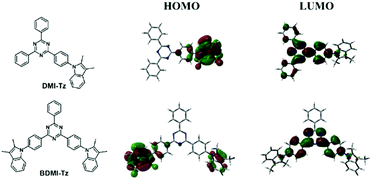当前位置:
X-MOL 学术
›
New J. Chem.
›
论文详情
Our official English website, www.x-mol.net, welcomes your
feedback! (Note: you will need to create a separate account there.)
2,3-Dimethylindole as a donor for novel thermally activated delayed fluorescence emitters
New Journal of Chemistry ( IF 2.7 ) Pub Date : 2020/01/10 , DOI: 10.1039/c9nj05736f Ming Liu 1, 2, 3, 4, 5 , Ming Shi 1, 2, 3, 4 , Hong Meng 1, 2, 3, 4
New Journal of Chemistry ( IF 2.7 ) Pub Date : 2020/01/10 , DOI: 10.1039/c9nj05736f Ming Liu 1, 2, 3, 4, 5 , Ming Shi 1, 2, 3, 4 , Hong Meng 1, 2, 3, 4
Affiliation

|
Two indole derivative-based light-emitting molecules are synthesized and studied. They share the same donor unit, 2,3-dimethylindole, and release similar emission colors. In addition, they posses almost the same lowest unoccupied molecular orbital and highest occupied molecular orbital energy levels. However, the discrepancy in the amount of 2,3-dimethylindole donor units in each molecule, results in different energy gaps between singlet and triplet states, and different reverse intersystem crossing process efficiency. OLED devices based on these 2,3-dimethylindole compounds display external quantum efficiencies of 6.3% and 16.5% with greenish blue emission.
中文翻译:

2,3-二甲基吲哚作为新型热活化延迟荧光发射体的供体
合成并研究了两个基于吲哚衍生物的发光分子。它们共享相同的供体单元2,3-二甲基吲哚,并释放出相似的发射色。另外,它们具有几乎相同的最低未占据分子轨道能级和最高占据分子轨道能级。然而,每个分子中2,3-二甲基吲哚供体单元数量的差异导致单线态和三线态之间的能隙不同,以及不同的反向系统间交叉过程效率。基于这些2,3-二甲基吲哚化合物的OLED器件具有6.3%和16.5%的外部量子效率,并发出绿色的蓝光。
更新日期:2020-02-17
中文翻译:

2,3-二甲基吲哚作为新型热活化延迟荧光发射体的供体
合成并研究了两个基于吲哚衍生物的发光分子。它们共享相同的供体单元2,3-二甲基吲哚,并释放出相似的发射色。另外,它们具有几乎相同的最低未占据分子轨道能级和最高占据分子轨道能级。然而,每个分子中2,3-二甲基吲哚供体单元数量的差异导致单线态和三线态之间的能隙不同,以及不同的反向系统间交叉过程效率。基于这些2,3-二甲基吲哚化合物的OLED器件具有6.3%和16.5%的外部量子效率,并发出绿色的蓝光。











































 京公网安备 11010802027423号
京公网安备 11010802027423号